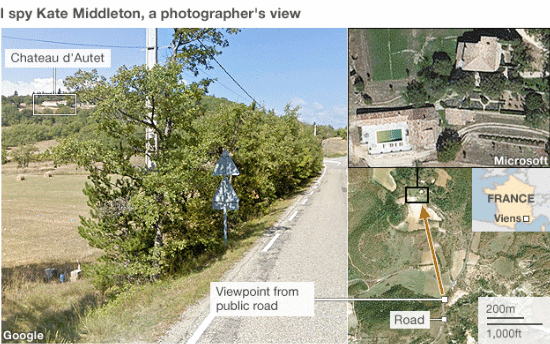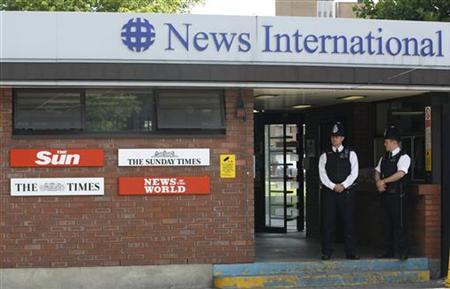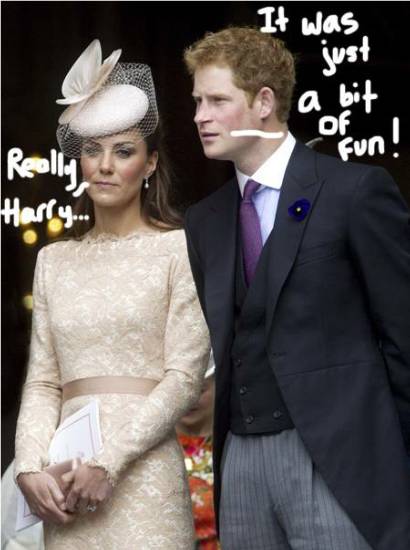
Image Credit: BBC News
Only a scant 23 days elapsed after TMZ leaked nude photos of Prince Harry that French tabloid Closer printed images of Kate Middleton sunbathing topless on the balcony of a Provence guesthouse. In addition to the frenzied speculation about the photos themselves (Is the queen upset with her grandson? Was Middleton truly in private, since she was photographed on a terrace? Are there more images that will emerge?) it’s interesting to note that the press itself has been the subject of equal amounts of scrutiny.
The issue of where these revealing pictures would be published quickly became one of the most discussed aspects of this story. While UK’s The Sun printed Prince Harry’s photos on its front page, the same tabloid refused to publish indiscreet images of Kate. The royal family has brought a lawsuit against Closer for a breach of privacy. And, CNN speculates that since TMZ ran Prince Harry’s images before any British newspaper, it might mean that 1) the American press effectively “scooped” their English counterparts and, 2) that digital media is outpacing print journalism. Though Prince Harry and the Duchess of Cambridge are – literally – on display in this controversy, the press has become just as visible as the royal family.

Image Credit: Reuters
Visual texts, such as paparazzi photos and newsstand images, have become the site for a global conversation about the our right to privacy (or publicity). Many journalists claim that Kate’s photos represent “an invasion of privacy,” since she and her husband were on a “remote property” when captured on film. Conversely, columnists have seized Prince Harry’s photos as evidence of his “wild ways,” deeming the young man irresponsible for allowing the images to surface publicly. Here, visual objects allow journalists to rhetorically construct the ethos of those represented in the images.
By employing the language of the public/private split, news writers unwittingly wade into a long-standing scholarly debate on the same subject. It’s curious (or very, very appropriate) to see Kate Middleton’s images associated with privacy (which was “brutal[ly]” invaded), while the visual documentation of Prince Harry’s partying has been labeled “indisputably in the public domain.” Public sphere theorist Michael Warner points out in Publics and Counterpublics (2005) that women have long been associated with the private sphere (the home, the family) while “masculinity, at least in Western cultures, is felt partly in a way of occupying public space” (24). Though both members of the royal family could have reasonably expected privacy while undressing – Kate at a friend’s home, Harry in a hotel suite – journalists locate the Duchess’s nudity in the private sphere, and the Prince’s in public.
Not only are the distinctions between public and private increasingly articulated in visual terminology, as I argue above, but they are also defined on and through the medium of the body. Feminist scholar Elizabeth Grosz unpacks the many significations we commonly heap onto the body in Volatile Bodies (1994): embodiment often becomes the physical locus for distinctions between
reason and passion, sense and sensibility, outside and inside, self and other, depth and surface, reality and appearance, mechanism and vitalism, transcendence and immanence, temporality and spatiality, psychology and physiology, form and matter, and so on. (3)
It seems that royal bodies bear an especially hefty portion of the conceptual weight we assign to the flesh as matter. Both the Duchess Catherine and Prince Harry’s bodies have become the site for a global discussion about the public vs. the private.
These sovereign bodies have also been used to flesh out (pun intended) our contemporary attitudes towards sex. The press has criticized Prince Harry’s licentiousness and lauded Her Highness’ sense of family duty, and I speculate that the disparity between these two reactions has something to do with the context in which their bodies appear. Middleton’s photos locate her in the frame of a heterosexual, monogamous, married, relationship. Swirling pregnancy rumors also link her sexuality with procreation. Reporters implicitly assign her to what Gayle Rubin calls the “Charmed Circle” of “good, normal, natural” sex. Rubin outlines the differences between taboo and accepted sexual practices in her 1984 essay “Thinking Sex,” even providing a succinct chart to illustrate her argument.
![This image depicts a circle with and inner and outer layer. Within the center layer are various "charmed" sexual statuses, like "Vanilla, Married, Procreative, [and] Same Generation"; on the outside are various non-traditional sexual practices like "in sin, Promiscuous, For money, [and] in the park."](../../files/gayle-rubin-chart.jpg)
Image Credit: University of Victoria
The press positions Prince Harry’s sexuality in Rubin’s “Outer Limits,” or, what dominant culture often deems “bad, abnormal, unnatural” sex. Since the images depict the young prince alongside several similarly unclothed women, media sources accuse him of participating in casual, promiscuous, and unmarried sex. His activities are seen as non-procreative and in a group, as opposed to within a relationship. Rubin’s writing might explain why journalistic rhetoric holds Prince Harry culpable for his own photos while exonerating the Duchess of Cambridge: his body is linked to non-normative sex, and hers isn’t.
Some tabloid websites, including The Hollywood Gossip, suggest that the leak of Harry’s photos “constitutes an epic failure on his handlers’ part.” The website argues that both Prince Harry and his “people” were “either clueless or careless” by not forcing the women with whom Harry was pictured to hand over their phones before the party began. This article implicitly raises the issue of control, blaming Harry for failing to reign in not only his own behavior, but the actions of those around him as well. This terminology of bodily control evokes the logic of Cartesian dualism, in which the activity of the mind gets contrasted with the inert body. The Cartesian theorization of the body typically reads corporeality in “naturalistic, organic, passive, inert terms, seeing it as an intrusion on or interference with the operation of the mind, a brute givenness which requires overcoming” (Grosz 3-4). Western philosophy typically construes the body as a blank slate onto which cultural norms get projected, or, as formless matter awaiting shape from the thinking mind.

Image Credit: PerezHilton.com
In being shocked by the prince’s lack of control, casting him as “careless,” the rhetoric of many journalists links up with the long-standing tradition of viewing the body as brute matter in need of discipline. Relying on and perpetuating the logics of Cartesian binarism, websites like The Hollywood Gossip condemn the prince because he refuses to “overcome” bodily excess. Because this rhetoric suggests the prince possesses an out-of-control corporeality, he is feminized. To return again to Grosz’s explication of Cartesianism, she points out that within the mind/body distinction, the “coupling of mind with maleness” leads to the association of “the body with femaleness” (4). Masculinity is graced with knowledge, thought, and enlightened rationalism, and femininity is bound to bodily excess. Unlike his sister-in-law, whose marital status the press seizes as an example of control and discipline (affording to her the privilege of masculinity’s “disavowal of the body”?), Prince Harry is constructed in feminine terminology by popular rhetoric (Grosz 4).
My final thoughts on this matter concern how the actions of the popular press affect even the most pedestrian, un-famous individuals (like you or me). The now ubiquitous claim that the press wronged Kate Middleton by invading her privacy has suggestive ramifications. By saying that photographers breached her privacy we imply that privacy is somehow sacred, or a space where an individual can exert control over their body. Does this association between privacy and autonomy correlate to the idea that publicity is not sacred? Put another way: if Middleton should have been protected under the guise of her privacy, would she not be protected in a public setting? I’ll admit, the question sounds a bit silly. But, I’d like to believe that even in public spaces we have the right to control our bodies, how they are represented, and what’s done to them. Personally, I would rather frame the issue in terms of consent: the widespread publication of these photos troubles me because neither Prince Harry nor the Duchess of Cambridge were given the opportunity to consent to the literally global display of their bodies.
Comments
Maryann Murphy